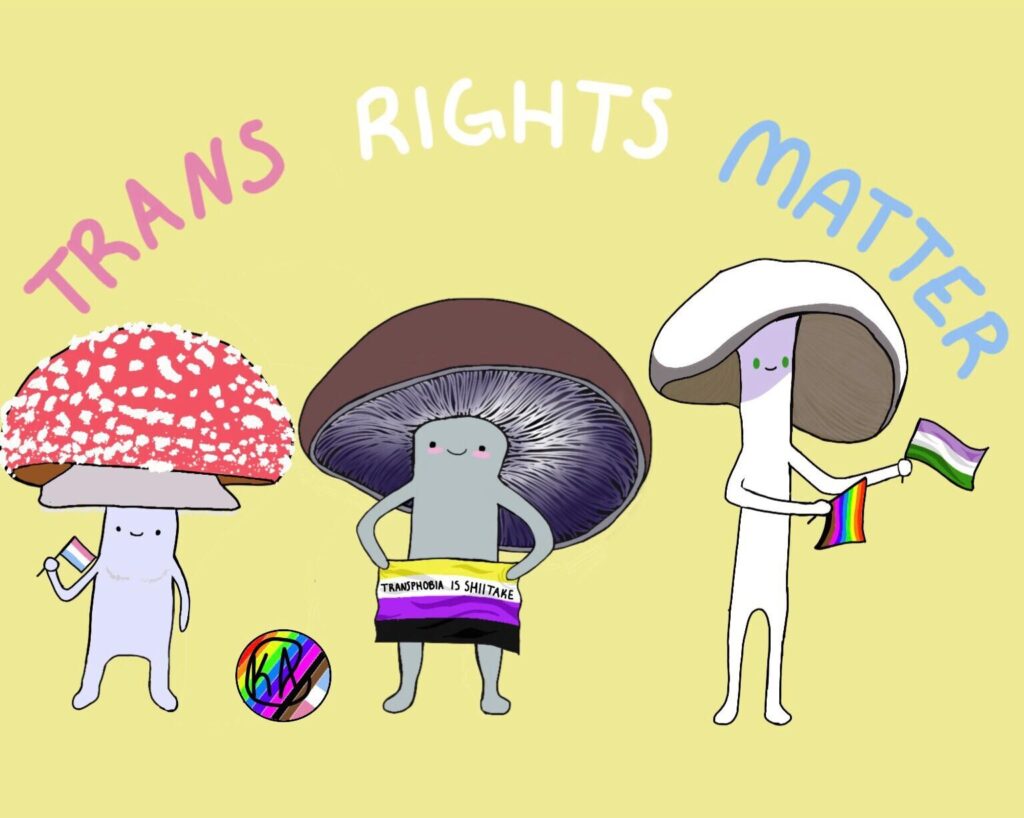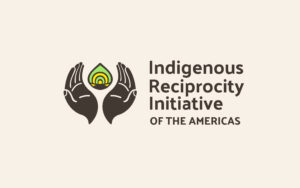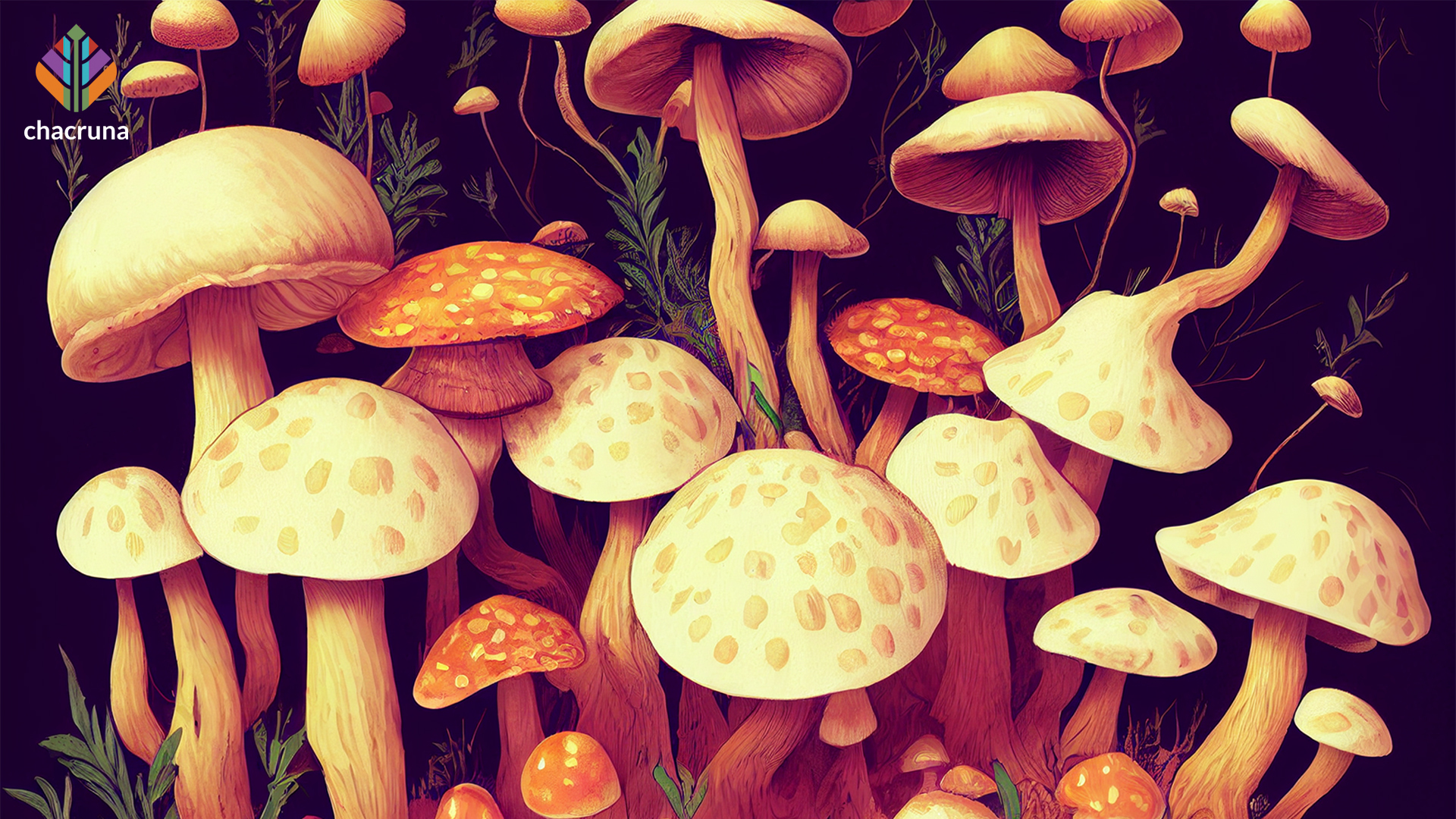- Five Things Mushrooms & Non-Binary People Have in Common - February 4, 2023
“Mycology is queer insofar as it is marginal, subordinate, contested, ridiculed, but more critically, mycology is queer insofar as it is disruptive, collective, transformative, revolutionary.”
Dr. Patricia Kaishian
What do mushrooms and non-binary people have in common? Though this might sound like the set-up of a bad joke, this question was the impetus for this essay. As a non-binary person, I feel an intense kinship with fungi, and when I started my journey into mycology, I wanted to find out why I felt this connection so profoundly. As I learned more, the parallels between fungi and queerness became impossible for me to ignore. I hope everyone who reads this will learn something. I further hope that it might validate other non-binary and gender-expansive folx’ experiences and give them a sense of being seen, as building a relationship with fungi has personally done for me. (A quick fun fact before we get into it all: In the Mycological Society of America’s 2018 survey, 12% of mycologists identified as LGBTQ+, three to four times the national reported average!)
So… What Do Fungi and Non-Binary People Have in Common?
Maybe not so surprisingly, fungi and queer people do have a lot in common, much of it manifesting on large-scale, societal levels, both historically and to this day. Although we’ll begin with the yuckier stuff, we’ll end with the positives!

#1: General Lack of Understanding
When Carl Linnaeus, the “father of modern taxonomy,” began labeling things in the 1700s, he established just two kingdoms: plants and animals. Bewildered by the admittedly often-confounding nature of fungi, he viewed the species he found as “primitive,” as they lacked most similarities to plants, and subsequently classified them as “lower plants.” Fungi weren’t recognized as distinct organisms until 1969; that’s relatively recently—just over 50 years ago! (Thanks to Robert Whittaker!) Linnaeus’s misclassification led to centuries of misunderstanding and is why we are still woefully uneducated about fungi.
I see parallels with this lack of recognition in the history of the trans* and gender-expansive movement. The trans* movement, in general, has largely been invisible throughout history, and although some progress has been made in the past few decades, non-binary and gender-expansive identities are still fighting for recognition and validity. This, of course, has a lot to do with how these identities challenge the gender binary—a topic we will continue to explore below.
#2: Invisibility & Erasure
When we force things into boxes that deny their true nature, we assist in their extinction. This can manifest, for example, as the struggle around fungal conservation efforts or, in the case of non-binary identities, the invalidation of their existence. Fungal conservation is difficult because, since we don’t fully understand them, we can’t fully protect them. In fact, most fungi remain so unrecognized, they don’t even have names. Only about 4% of species have been identified and named—that’s about 120,000 of an estimated 2.2 to 3.8 million species (Kaishian & Djoulakian, 2020, p. 15)!
Here, I see parallels between fungi’s invisibility and the erasure of non-binary and gender-expansive identities. A too-common occurrence for non-binary people is having to debate our very existence. Historically, trans* people have had a much easier time being accepted by others the more they “pass.” Passing—a heteronormative concept that I think needs to be officially retired—refers to when a trans* person’s gender expression aligns with the gender binary, meaning they look like what society tells us a (cis-)“man” or (cis-)“woman” should look like. Non-binary or gender-expansive people, who don’t want to follow these socially-constructed expectations, challenge this and are, therefore, feared. This fear can present in different forms, from avoidance and erasure to discrimination and invalidation to full-on hate and violence.

Discover the Indigenous Reciprocity Initiative of the Americas
#3: Societal Phobias
Relatedly, fungi and queer people each happen to have their own phobias: mycophobia and queerphobia, respectively. Mycophobia is the societal fear and repulsion of fungi, which manifests in many ways. For example, children are generally taught not to touch any mushrooms as they are automatically considered dangerous; however, little emphasis is placed on which plants not to handle. There are hundreds—if not thousands—of dangerous plants; in contrast, only one fungus species, poison fire coral (native to Japan), has been found to be dangerous to touch. Additionally, of the approximately 120,000 identified species, only about 100 are toxic when eaten, and only 15–20 of those are potentially lethal.
A further example of mycophobia is the lack of mycological studies in education. Mycology, or almost anything about fungi, is rarely taught at any level of schooling, and if it is, it is usually pathologized. Similarly, queer experiences are rarely incorporated into curricula and, when they are, are also routinely pathologized. This is one commonality between mycophobia and queerphobia.
Another aspect that mycophobia and queerphobia share is how, under their influence, negative qualities get “mapped” onto the whole. As noted in the example above, very few species of fungi are actually dangerous. However, thanks to mycophobia, we are taught that all fungi are dangerous and should be avoided and feared. The negative qualities of a handful of species (out of the millions that exist) color our perception of the group as a whole. A similar phenomenon happens to queer identities because of queerphobia. Kaishian and Djoulakian (2020) summarize it perfectly: “In general, people who belong to marginalized groups experience a flattening of their person into a static state that suggests behaviors by individual members of a group can be generalized onto the supposedly singularly definable quality of the group as a whole” (p. 11).
We can find yet another commonality in the language used. As Kaishian and Djoulakian (2020) note, “fungi are seen as poisonous, agents of disease, degenerate, deadly, freaky, gross, and weird—language historically leveled against both queer and disabled people” (p. 9). Finally, dualistic or binary thinking permeates both mycophobic and queerphobic discourse. As mentioned, by their very nature, fungi and queer people challenge and help deconstruct many of the binaries our society has relied upon for some time.
#4: Deconstruction of Binaries
Nature is often used to explain and validate normative human behaviors and experiences. However, this exploration is almost exclusively done through a cis-heteronormative lens—that is, assumptions are overwhelmingly made based on white, colonial, Christian, heterosexual, cisgender, male, and able-bodied experiences of the world. By default, this framework creates rigid binaries: Anything “non-normative” (by cis-heteronormative standards) is “unnatural.” This erases and invalidates, I would argue, the majority of human experiences and leads to a deep misunderstanding of ourselves, others, and reality as a whole.
Such inflexible binary views make it difficult, if not impossible, even to ask questions—let alone find answers—that aren’t binary. The Queendom (or, better yet, Queerdom) of Fungi forces us to look at the world differently by challenging many of the binaries humans have created. Though not a comprehensive list of what needs to be deconstructed, the binaries of sex assigned at birth (male/female) and gender identity (man/woman) will be the focus of discussion here.
Socially Constructed Binary #1: Sex
Fungi defy this binary by showing us that two biological sexes are not the rule, but rather the exception. It is rare for a species to have just two mating types; in fact, some species, such as Schizophyllum commune, have as many as 23,000! They also defy our “rules” of reproduction: Some reproduce asexually, some have two sets of reproductive systems (monoecious), some have distinct bodies for different sets (dioecious), and sometimes monoecious and dioecious bodies co-occur! Almost any combination is possible, depending on the species you’re studying.
Mushrooms defy our “rules” of reproduction.
We don’t even have to look to fungi to deconstruct this binary, though. Intersex people, or those born with genetic, hormonal, or physical sex characteristics that are not typically “male” or “female,” comprise almost 2% of the population—about the same number as redheads. There are over thirty intersex variations! Some are visibly obvious, while some are not (have you had your chromosomes tested?), so many people may not know they are intersex. Also, it’s important to note that not all intersex people identify as queer—but there is significant overlap between the groups. Accurate statistics are currently tough to find, but Mari Wrobi, in their fantastic essay “Life at the Trans-Intersex Intersection,” writes that up to 40% of intersex people identify as trans* (Dale & Wrobi, 2021, p. 117).
Socially Constructed Binary #2: Gender
Of course, fungi don’t have gender identities. but, as mentioned, they do disrupt the plant/animal binary. As discussed above, this “new” category confused scientists and wasn’t even recognized as distinct until 1969. Fungi resist objectivity and standardization, and their lack of conformity to quantifiable boxes engenders insecurity, fear, and even hatred. This, I would argue, is also why there is so much fear surrounding non-binary and gender-expansive identities that disrupt the gender (man/woman) binary. We won’t check either of the two boxes we are given as options, so we create our own. This confounds and frustrates people—as fungi did to Linnaeus—who want to uphold binary ways of life. But we shouldn’t back down; as Kate Kincaid writes in her essay in the book Queering Psychedelics, “there is freedom in choosing your boxes and rearranging them in whatever combination you want. It’s liberating to truly know that you can check any or none of the boxes and fluidly change them at any time” (p. 174).
#5: Resilience & Significance
Humans wouldn’t exist without fungi; the Earth as we know it also wouldn’t exist. Over 90% of terrestrial plants form mycorrhizal relationships with different species of fungi; they depend on the fungi to thrive. We inhale between one and ten fungal spores each time we breathe. Fungi are distributed throughout our bodies—termed our mycobiome, a small but important part of our microbiome—and we rely on certain species for basic bodily functions (Kaishian & Djoulakian, 2020, p. 8). Fungi are in us, all around us, and an integral part of being human on this planet!
Like fungi, non-binary and gender-expansive people always have and will continue to exist and serve vital roles in human existence across time and places.
Like fungi, non-binary and gender-expansive people always have and will continue to exist and serve vital roles in human existence across time and places. We both challenge—and will continue to deconstruct—the harmful socially constructed binaries created by the systems of power that have been and are still currently in place: white supremacy, cisnormativity, heteronormativity, etc. We must allow space for new ways of thinking so we can continue to better understand ourselves, others, and the world around us—and fungi can aid us in this endeavor by studying and consuming (certain species of) them. As Kaishian and Djoulakian (2020) write, “It is past time that humans turn to the fungi to which we are bound, step into our mutual totality, and create space and futures for our wild ways of being” (p. 24).
Art by Trey Brasher.
References
Belser, A., Cavnar, C., & Labate, B. C. (eds) (2022). Queering psychedelics: From oppression to liberation in psychedelic medicine. Synergetic Press.
Dale, L. K., & Wrobi, M. (2021). Life at the Trans-Intersex Intersection. In Gender euphoria: Stories of joy from trans, non-binary and Intersex Writers (pp. 111–122). essay, Unbound.
Eichenbaum, J. (2018, October 9). Dissolving the binary: The Queerness of Psychedelics. Chacruna Institute for Psychedelic Plant Medicines. Retrieved November 30, 2022, from https://chacruna.net/dissolving-binary-queerness-psychedelics/
Kaishian, P., & Djoulakian, H. (2020). The Science Underground: Mycology as a Queer Discipline. Catalyst: Feminism, Theory, Technoscience, 6(2), 1–26. https://doi.org/10.28968/cftt.v6i2.33523
Take a minute to browse our stock:
Did you enjoy reading this article?
Please support Chacruna's work by donating to us. We are an independent organization and we offer free education and advocacy for psychedelic plant medicines. We are a team of dedicated volunteers!
Can you help Chacruna advance cultural understanding around these substances?














